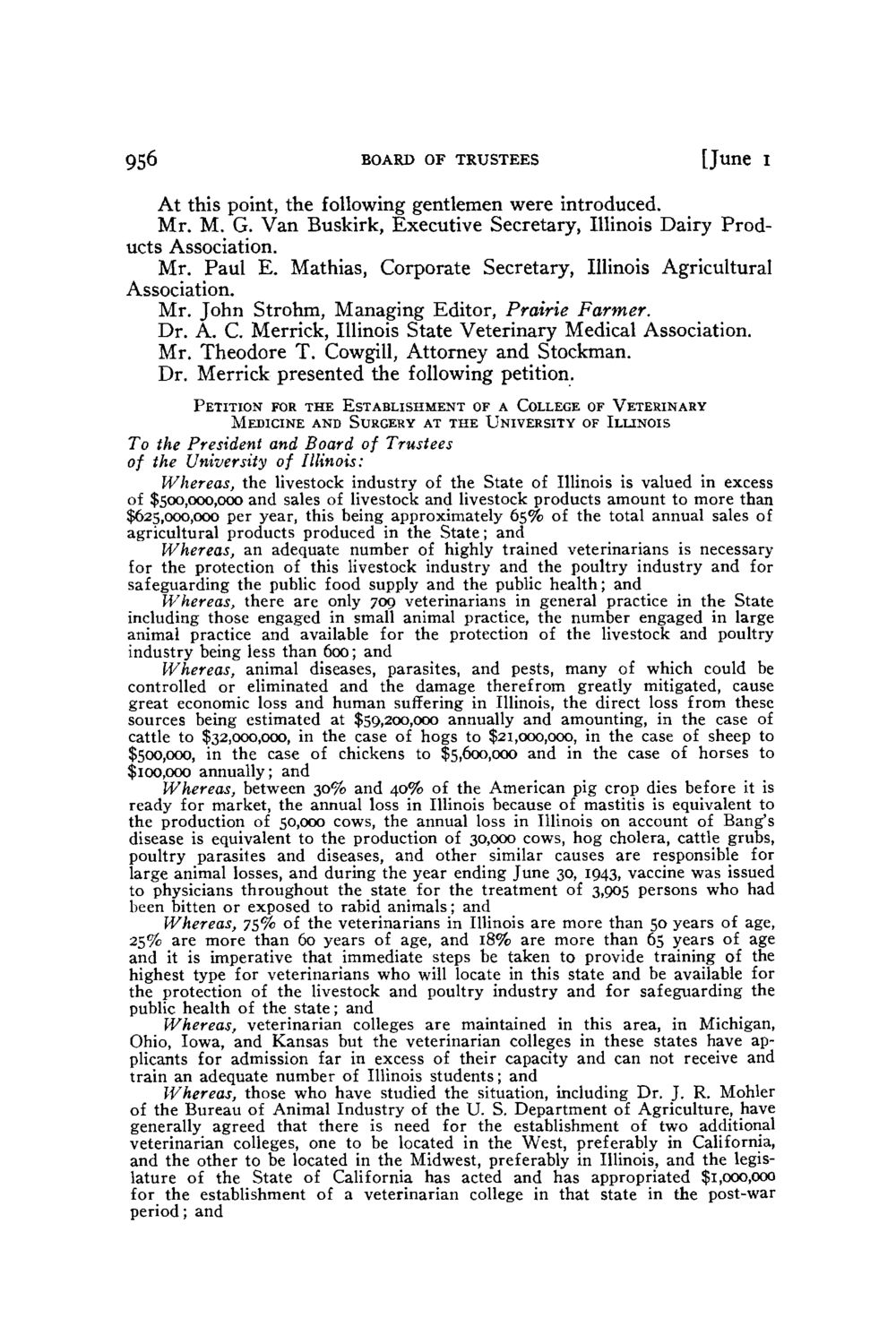| |
| |
Caption: Board of Trustees Minutes - 1944
This is a reduced-resolution page image for fast online browsing.

EXTRACTED TEXT FROM PAGE:
956 BOARD OF TRUSTEES [June i At this point, the following gentlemen were introduced. Mr. M. G. Van Buskirk, Executive Secretary, Illinois Dairy Products Association. Mr. Paul E. Mathias, Corporate Secretary, Illinois Agricultural Association. Mr. John Strohm, Managing Editor, Prairie Farmer. Dr. A. C. Merrick, Illinois State Veterinary Medical Association. Mr. Theodore T. Cowgill, Attorney and Stockman. Dr. Merrick presented the following petition. PETITION FOR THE ESTABLISHMENT OF A COLLEGE OF VETERINARY MEDICINE AND SURGERY AT THE UNIVERSITY OF ILLINOIS To the President and Board of Trustees of the University of Illinois: Whereas, the livestock industry of the State of Illinois is valued in excess of $500,000,000 and sales of livestock and livestock products amount to more than $625,000,000 per year, this being approximately 6 5 % of the total annual sales of agricultural products produced in the State; and Whereas, an adequate number of highly trained veterinarians is necessary for the protection of this livestock industry and the poultry industry and for safeguarding the public food supply and the public health; and Whereas, there are only 709 veterinarians in general practice in the State including those engaged in small animal practice, the number engaged in large animal practice and available for the protection of the livestock and poultry industry being less than 600; and Whereas, animal diseases, parasites, and pests, many of which could be controlled or eliminated and the damage therefrom greatly mitigated, cause great economic loss and human suffering in Illinois, the direct loss from these sources being estimated at $59,200,000 annually and amounting, in the case of cattle to $32,000,000, in the case of hogs to $21,000,000, in the case of sheep to $500,000, in the case of chickens to $5,600,000 and in the case of horses to $100,000 annually; and Whereas, between 30% and 40% of the American pig crop dies before it is ready for market, the annual loss in Illinois because of mastitis is equivalent to the production of 50,000 cows, the annual loss in Illinois on account of Bang's disease is equivalent to the production of 30,000 cows, hog cholera, cattle grubs, poultry parasites and diseases, and other similar causes are responsible for large animal losses, and during the year ending June 30, 1943, vaccine was issued to physicians throughout the state for the treatment of 3,005 persons who had been bitten or exposed to rabid animals; and Whereas, 75% of the veterinarians in Illinois are more than 50 years of age, 25% are more than 60 years of age, and 18% are more than 65 years of age and it is imperative that immediate steps be taken to provide training of the highest type for veterinarians who will locate in this state and be available for the protection of the livestock and poultry industry and for safeguarding the public health of the state; and Whereas, veterinarian colleges are maintained in this area, in Michigan, Ohio, Iowa, and Kansas but the veterinarian colleges in these states have applicants for admission far in excess of their capacity and can not receive and train an adequate number of Illinois students; and Whereas, those who have studied the situation, including Dr. J. R. Mohler of the Bureau of Animal Industry of the U. S. Department of Agriculture, have generally agreed that there is need for the establishment of two additional veterinarian colleges, one to be located in the West, preferably in California, and the other to be located in the Midwest, preferably in Illinois, and the legislature of the State of California has acted and has appropriated $1,000,000 for the establishment of a veterinarian college in that state in the post-war period; and
| |